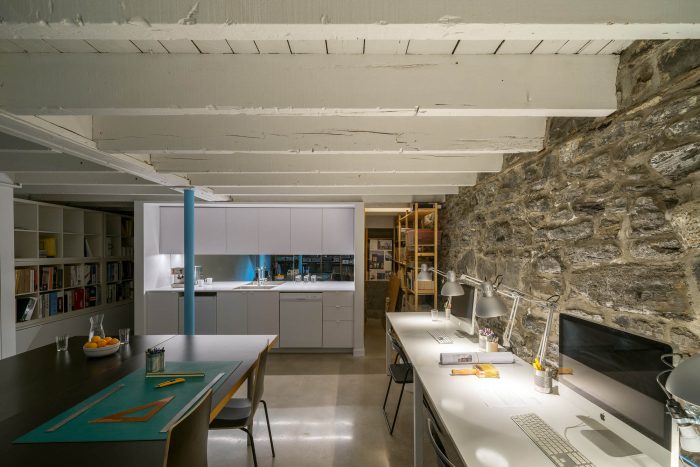Naturehumaine将搬进位于吉尔福德街拐角处的一栋百年老建筑,这栋建筑位于广场上,由退休后的街区标志性鞋匠吉吉先生留下。
Naturehumaine is moving into a century-old building on the corner of Gilford Street, in the square left by Mr. Jiji, the emblematic shoemaker of the neighbourhood who retired.
该项目旨在恢复建筑的历史特征,保留本地企业的灵魂,同时赋予其现代感。 工作室分两层,底层是主要工作区和会议室。地下室则是厨房、餐厅、材料库和档案区。 主要的干预措施是在侧面改造以前的内院,安装办公室的主入口。
The project aims to restore the building’s heritage features and preserve the soul of a local business while giving it a contemporary touch. The atelier is set up on 2 levels; on the ground floor is the main work area and the meeting room. The basement becomes a kitchen, dining room, material library and archive area. The major intervention was to renovate the former inner courtyard on the lateral side, to install the main entrance of the office.
这个新的空间是进入工作空间前的一个过渡门槛。大面积的玻璃入口结合了一些用于展示建筑模型的架子。在后面,会议室被一块条纹玻璃板隐藏起来,创造了一种光和运动的游戏,同时保留了其使用者的隐私。
This new space serves as a transition threshold before entering the workspace. The largely glazed entrance incorporates a few shelves used to display architectural models. At the back, the meeting room is concealed by a striated glass panel, creating a play of light and movement while preserving the privacy of its occupants.
在街角处,朝南的窗户提供了安装一个大型玻璃地板的机会,支撑在现有的横梁上,让光线通过地下室。它揭示了一个新的私密空间,被粗糙的碎石基础和裸露的天花板托梁所包围。
At the corner street, the south-facing window provides the opportunity to install a large glass floor supported on the existing beams, allowing light to pass through to the basement. It reveals a new intimate space, enveloped by the rough texture of the rubble foundation and exposed ceiling joists.
建筑结构的特点是两根柱子,保留了建筑前住户选择的原始蓝色,称为 “bleu de baltes”。这两根柱子协调了空间组织,导致了办公室的纵向排列。工作台之间用木头和毛毡叶片组成的屏风是为了提高空间的音质。 所有定制的家具都提供了一个研究和实验的机会。
The structure of the building is characterized by two columns that retain their original blue chosen by the previous occupant of the building, called “bleu de baltes”. Orchestrating the space organization, these columns lead to the longitudinal arrangement of the offices. A screen of wood and felt blades between the worktables was designed to improve the sound quality of the space. All the custom-made furniture offered an opportunity for research and experimentation.
所使用的材料构成了一个简单和极简主义的调色板,汇集了naturehumaine最喜欢的材料的成就,木材,马赛克,混凝土地板,纹理玻璃和钢。其目的是创造一个有利于集中精力和创造力的工作氛围。
The materials used constitute a simple and minimalist palette compiling the favourite materials of naturehumaine’ s achievements, wood, mosaic, concrete floors, textured glass and steel. The aim is to create a work atmosphere propitious to concentration and creativity.
建筑师:NatureHumaine
年份:2020年
摄影:Ronan Mezière
城市:蒙特利尔
国家:加拿大
Architects: NatureHumaine
Year: 2020
Photographs: Ronan Mezière
City:Montreal
Country:Canada





















